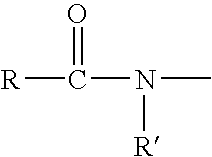Tricyclic androgen receptor modulator compounds and methods
a technology of androgen receptors and modulators, applied in the field of nonsteroidal compounds, can solve the problems of not fully exploring the possibility of men receiving similar hormone therapy
- Summary
- Abstract
- Description
- Claims
- Application Information
AI Technical Summary
Benefits of technology
Problems solved by technology
Method used
Image
Examples
example 1
7,8-Dihydro-7,7-dimethyl-2-isopropoxy-4-trifluoromethyl-8H-pyridino[3,2-f]quinoline (Compound 101, Structure 4 of Scheme I, where R1=R2=methyl)
[0268]6-Amino-2-isopropoxy-4-trifluoromethylquinoline (Compound 102, Structure 2 of Scheme 1):
[0269]In a 250-mL r.b. flask, a solution of 4-trifluoromethyl-6-nitroquinolinone (structure 1 of Scheme I) (3.78 g, 14.6 mmol) in DMF (75 mL) was treated with CsF (12.41 g, 73 mmol, 5.0 equiv.) and 2-iodopropane (11.09 g, 73 mmol, 5.0 equiv). The reaction mixture was stirred at room temperature (rt) for 18 h. The reaction mixture was quenched with H2O (100 mL) and extracted with EtOAc (3×200 mL). The combined EtOAc extracts were washed with saturated aqueous NH4Cl solution (300 mL), H2O (300 mL) and brine (300 mL). Dried (MgSO4), filtered and concentrated in vacuo. The residue was purified by flash column chromatography (SiO2, 5×20 cm, 2% EtOAc in hexane as eluent) to afford 3.94 g (90%) of the 2-isopropoxyquinoline as a white solid. Rf 0.81 (SiO2, 1...
example 2
5,6,7,8-Tetrahydro-7,7-dimethyl-2-isopropoxy-4-trifluoromethylpyridino[3,2-f]quinoline (Compound 103, Structure 5 of Scheme I, where R1=R2=methyl)
[0273]In a 250-mL r.b. flask, a solution of compound 101 (3.64 g, 10.8 mmol) in TFA (50 mL) was treated with NaBH4 caplets (4.5 g, 119 mmol, 11 equiv). The reaction mixture was stirred at rt for 20 h. The reaction mixture was poured onto 200 mL of ice-water, neutralized with NaHCO3 powder to pH 7 and extracted with EtOAc (3×250 mL). The combined extracts were washed with brine (2×200 mL), dried (MgSO4), filtered and concentrated in vacuo. The residue was purified by flash column chromatography (SiO2, 5×20 cm, 5% EtOAc in hexane as eluent) to afford 3.38 g (92%) of compound 103 as a yellow solid. Rf 0.50 (SiO2, 10% EtOAc-hexane). 1H NMR (400 MHz, CDCl3) 7.56 (d, 1H, J=8.8), 7.24 (s, 1H), 6.89 (d, 1H, J=8.8), 5.46 (septet, 1H, J=6.2), 3.85 (s, 1H), 3.07 (t, 2H, J=6.5), 1.68 (t, 2H, J=6.5), 1.38 (d, 6H, J=6.2), 1.26 (s, 6H).
example 3
5,6,7,8-Tetrahydro-7,7-dimethyl-4-trifluoromethylpyridino[3,2-f]quinolin-2(1H)-one (Compound 104, Structure 6 of Scheme I, where R1=R2=methyl)
[0274]In a 250-mL r.b. flask, a solution of compound 103 (3.97 g, 11.7 mmol) in AcOH (50 mL) was treated with conc. HCl (50 mL). The reaction mixture was heated to 95° C. and stirred for 4 h. After cooling to rt, the reaction mixture was poured onto ice-water, neutralized with NaHCO3 powder to pH 7 and extracted with EtOAc (3×500 mL). The combined extracts were washed with H2O (500 mL) and brine (500 mL), dried (MgSO4), filtered and concentrated in vacuo. The residue was purified by recrystallizing from EtOAc / hexane to afford 3.42 g (98%) of compound 104 as a yellow-orange solid. 1H NMR (400 MHz, CDCl3) 10.35 (br. s, 1H), 7.27 (d, 1H, J=8.6), 7.25 (s, 1H), 6.82 (d, 1H, J=8.6), 3.80 (s, 1H), 3.03 (t, 2H, J=6.5), 1.67 (t, 2H, J=6.5), 1.24 (s, 6H).
PUM
| Property | Measurement | Unit |
|---|---|---|
| pH | aaaaa | aaaaa |
| wt % | aaaaa | aaaaa |
| wt % | aaaaa | aaaaa |
Abstract
Description
Claims
Application Information
 Login to View More
Login to View More - R&D
- Intellectual Property
- Life Sciences
- Materials
- Tech Scout
- Unparalleled Data Quality
- Higher Quality Content
- 60% Fewer Hallucinations
Browse by: Latest US Patents, China's latest patents, Technical Efficacy Thesaurus, Application Domain, Technology Topic, Popular Technical Reports.
© 2025 PatSnap. All rights reserved.Legal|Privacy policy|Modern Slavery Act Transparency Statement|Sitemap|About US| Contact US: help@patsnap.com



